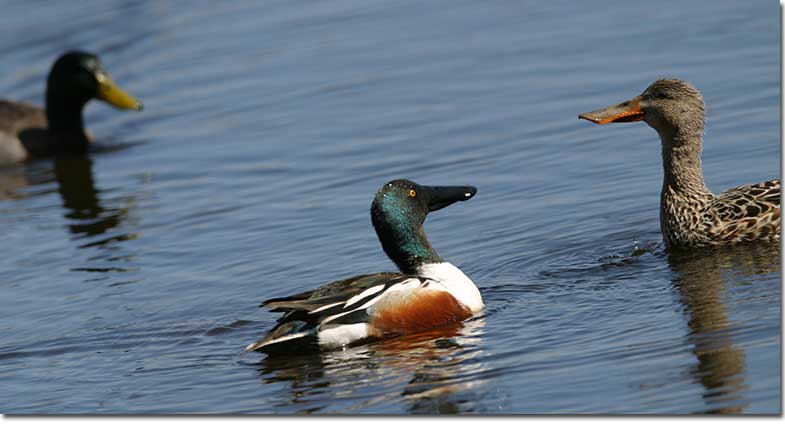
The birds of Wyoming are 452 species of raptors, grouse, ducks, and many other species! In Wyoming, we find Golden Eagles soaring over wild sagebrush plains, pine forests with beautiful Western Tanagers, flocks of huge American White Pelicans in wheeling flight over wetlands, and much more!
There are a lot of exciting and beautiful birds in Wyoming. How many have you seen? We bet you’ve seen a lot, but how many species could you identify? You’re on the right place to learn more.
Most Common Birds of Wyoming
According to eBird data from 2022 to 2023, the following list shows the 30 most common birds of Wyoming.
To help identify them, we also included key tips about their behavior and field marks (remember that the species on the bottom of the list are common birds, too!).
American Robin
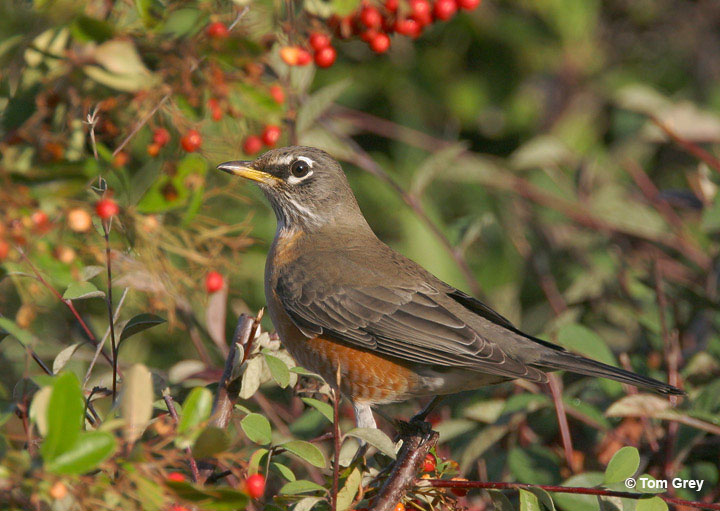
Scientific name: Turdus migratorius
Length: 10 inches
Weight: 2.7 ounces
Wingspan: 17 inches
Song: “cheery, cheery, cheery, cheery, cheer, cheer”
The American Robin is a familiar and common thrush that is dark gray above and brick red below. These robins also have orange-yellow bills, blackish heads with white markings around the eyes and on the throat, and white bellies.
Both sexes of this thrush species are similar, but males are darker above and more reddish on the underparts. Young American Robins have more white marks on their faces and spotting on orange underparts.
In flight, this common thrush in Wyoming also shows white corners in its outer tail feathers.
American Robins forage on the ground for worms, insects, snails, and other small creatures. In winter, these common birds flock together and perch in trees and bushes to eat berries and fruit.
The American Robin makes a cup nest in trees and lives in parks, woodlands, towns, and many other habitats. They reside in Alaska, most of Canada, the USA, and in Mexico.
Key Identifications:
- Fair-sized songbird that is dark gray above, and brick red and white below.
- Forages for worms and bugs on lawns and other open grassy areas, also flocks together to feed on fruiting trees in the winter.
- Makes a cup nest in trees.
- The American Robin is quite vocal and makes a loud, sharp, “yenk!” call and quieter “check,check,check” calls. It also has a lovely cheerful song of caroled phrases, “cheery, cheery, cheery, cheery, cheer, cheer”.
Common Raven
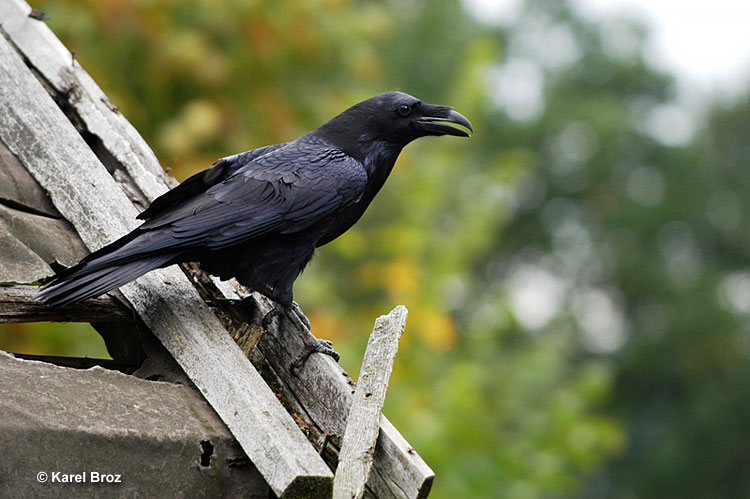
Scientific name: Corvus corax
Length: 24 inches
Weight: 2.6 pounds
Wingspan: 53 inches
Song: “Grauk Grauk Grauk Grauk!”
The Common Raven is a big, black crow-like bird with long, broad wings and a broad, wedge-shaped tail. Both sexes look alike and have feathers extending onto the top part of their strong, stout beaks.
This bird is often seen in soaring flight or in direct flight, where it gives a few strong flaps between glides.
Common Ravens are omnivores that feed on carrion, small animals, nesting birds, and various other food items. They forage by flying above roads and other places and are always on the lookout for feeding opportunities.
This big Corvid makes a big, bulky nest out of sticks and lines the shallow cup with mud, wool, and other items. It builds its nest on a cliff, tree, bridge, or other structure.
The Common Raven lives in wilderness areas from the Arctic to parts of the northeastern USA and the western USA. In some places, it lives in urban areas. Common Ravens are common in Wyoming.
Key Identifications:
- Huge, black, crow-like bird with a strong, stout beak and a wedge-shaped tail.
- An omnivore that feeds on small animals, carrion, and other food items.
- Makes a big bulky stick nest in trees, on cliffs, and on human-made structures.
- Common Ravens are vocal birds. One of their most common calls is a load and croaking, “Grauk Grauk Grauk Grauk!”.
Canada Goose
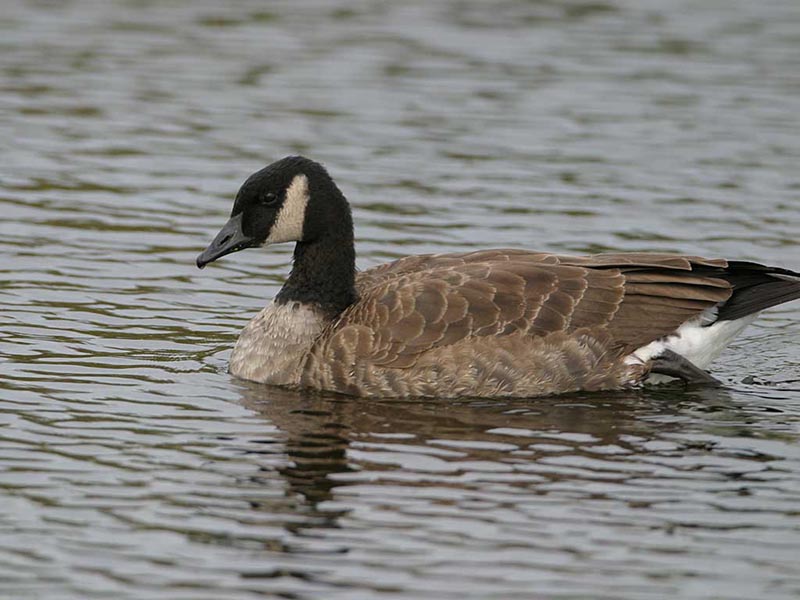
Scientific name: Branta canadensis
Length: 35 – 45.2 inches
Weight: 5.29 – 19.8 pounds
Wingspan: 50 – 67 inches
Song: “uurrRUNK! uurrRUNK!”
The Canada Goose is a large, grayish-brown bird with a long black neck, and black head with a white throat and cheeks. Males and females look alike and have pale barring, a white belly and undertail, and a short black and white tail.
They have strong, direct flight and make deep flaps with long, broad wings.
Canada Geese feed on grass, sedges, and other vegetation, grain, and berries. They forage by walking along and grazing, or picking food from the ground and bushes. This species also feeds by dipping its head below the surface of shallow water.
This large goose uses grass and other plants to make a large, shallow cup nest on a small mound or other elevated spot next to water.
The Canada Goose prefers open grassy areas and farm fields near water where it can feed and see predators before they get too close. They live in Alaska, most of Canada, and most of the USA, being one of the most common birds of Wyoming.
Key Identifications:
- Big, gray-brown goose with a long black neck, and black and white head.
- Grazes vegetation and forages for berries in wide open, grassy habitats near water like golf courses, parks, and airports.
- Makes a shallow, open cup nest on an elevated spot next to water.
- Vocal and often makes honking calls, “uurrRUNK! uurrRUNK!”.
House Sparrow
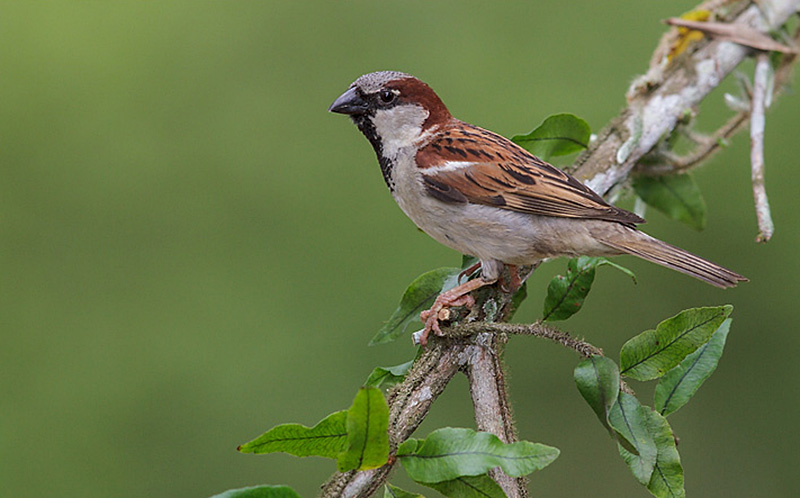
House Sparrow (Passer domesticus) perched on a branch in the Atlantic rainforest of southeast Brazil.
Scientific name: Passer domesticus
Length: 6.25 inches
Weight: .98 ounces
Wingspan: 9.5 inches
Song: “see,chirrup,see,chirrup,see,chirrup”
House Sparrows are small, plump gray and brown birds with conical, finch-like beaks. Males have a gray and rufous head with pale cheeks, and black near their eyes and on their throat.
The rest of their underparts are gray, and they have brown, streaked backs with rufous highlights. They also have a white mark on the shoulder of each wing and a grayish rump and tail. Females are plainer brown and buff, have paler beaks, and buff eyebrows.
House Sparrows feed on seeds, grain, and insects. They are regular visitors to bird feeders and often dominate other smaller species. They also forage on the ground in farmlands, parks, urban areas, and other open situations.
The House Sparrow nests in cavities. When searching for suitable nesting sites, they can kill and remove the eggs and young of smaller species.
House Sparrows usually live near people and occur in most of North America, including Wyoming.
Key Identifications:
- Brown and gray sparrow with a bold pattern on its head.
- Feeds on seeds, grain, and insects at feeders and on the ground in urban areas and farmlands.
- Nests in tree cavities, including nest boxes.
- This species is vocal and often makes short chirping calls. Its song is a friendly series of chirping sounds, “see,chirrup,see,chirrup,see,chirrup”.
Black-billed Magpie
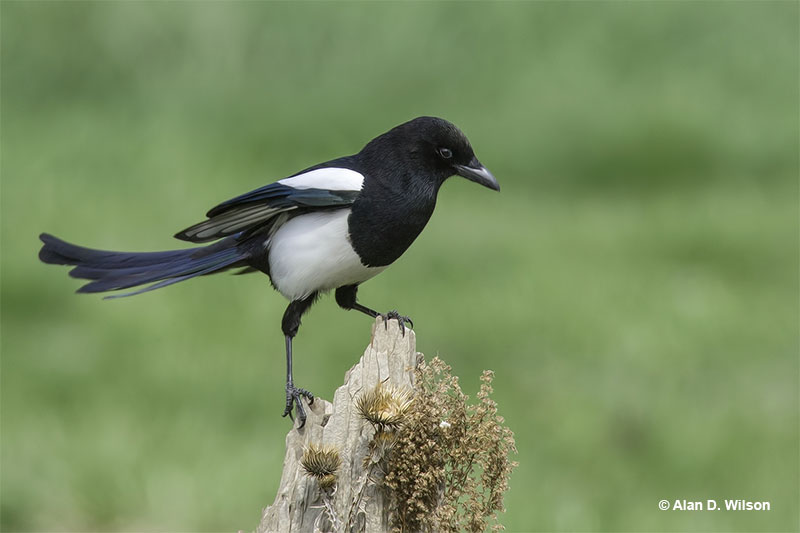
Scientific name: Pica hudsonia
Length: 19 inches
Weight: 6 ounces
Wingspan: 25 inches
Song: “reh reh reh reh reh!”
The Black-billed Magpie is a big, bold, black-and-white bird with a long tail. This relative of crows and jays has a stout, crow-like beak and glossy green and purple in its wings and tail.
Males and females look alike and also show bold white wing patches in flight. These birds fly with a few flaps followed by short, brief glides and usually occur in groups.
They are omnivorous and eat a wide variety of food items. In winter, magpies often scavenge animals killed by predators as well as roadkill. They also eat insects, small animals, seeds, and other items.
Black-billed Magpies make domed nests out of sticks and mud and build them in trees, poles, and other structures.
This species lives in a variety of open, semi-open, and wooded habitats in Alaska, western and central Canada, and much of the western USA south to New Mexico.
Key Identifications:
- Medium to large black and white bird with a black beak, and a long, glossy green and purple tail.
- Feeds on carrion, small animals, seeds, and other food scraps.
- Makes a domed nest out of mud and sticks.
- This vocal bird makes a repeated raspy vocalization, “reh reh reh reh reh!”.
Mallard
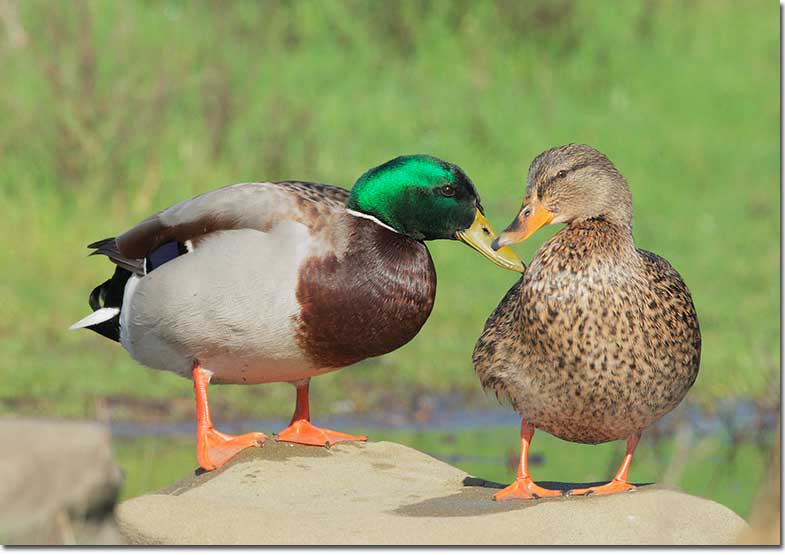
Mallard pair (Male and female)
Scientific name: Anas platyrhynchos
Length: 23 inches
Weight: 2.4 pounds
Wingspan: 35 inches
Song: “quack, quack”
The Mallard is a fairly large, familiar duck. The male has a metallic green head and chestnut breast. The rest of the bird is pale gray with pale brown, and black on its back and around its tail.
Female Mallards are mottled brown and buff with a dark crown and line through the eyes. In flight, both sexes show a green-blue wing patch bordered with white.
Mallards eat a variety of items, including insect larvae, snails, other small aquatic creatures, acorns, seeds, and grain. They forage by filtering and picking up food items in and near shallow water, and in farm fields.
This duck species makes a shallow nest with sticks and lined with down feathers. It builds its nest on the ground, hidden in grass or under a bush.
The Mallard lives in ponds, marshes, and many wetland habitats in Canada, USA, and Eurasia.
Key Identifications:
- Feeds on insect larvae, grain, seeds, and other items picked up with its bill in and near shallow water.
- Makes a shallow stick nest hidden in grass or under a bush.
- The female Mallard makes the classic “quack, quack” duck sound. Males make similar but softer sounds and a whistling call.
House Finch
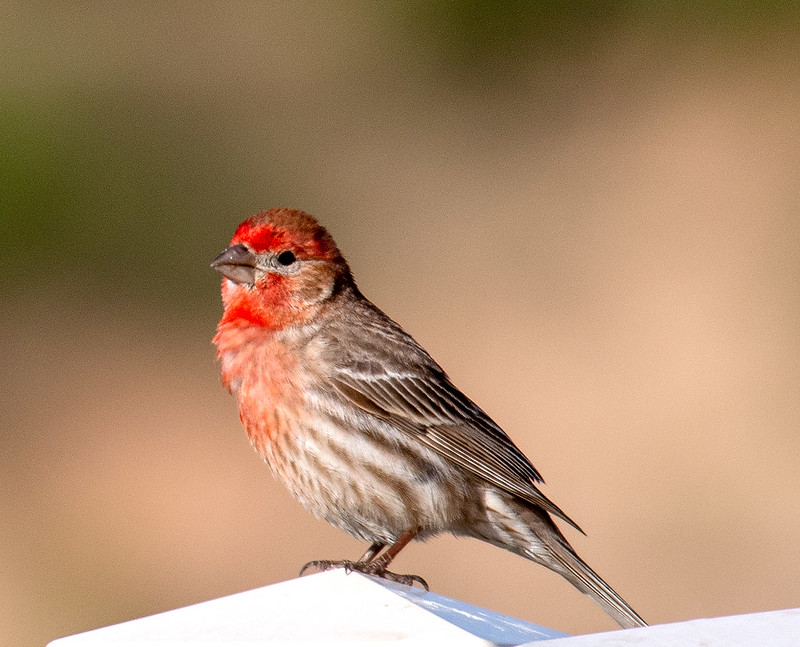
Photograph © John Hansen
Scientific name: Haemorhous mexicanus
Length: 6 inches
Weight: .88 ounces
Wingspan: 10 inches
Song: “chip,chip,chiprididip,ZREEYachip”
House Finches are sparrow-sized birds with dark, rounded beaks and fairly long wings. Males are orange-red or rose-red on their head, throat and breast, and have some red on their rump. They also have brownish streaks on their back, flanks, and white belly.
Like the male, female House Finches have two white wing bars on long, gray-brown wings. However, they lack red and are mostly streaked, dull brown-gray birds.
House Finches feed on seeds, buds, fruit, and flowers. They often visit feeders in Wyoming but also forage on the ground, and in bushes and trees.
We see these pretty birds in deserts and arid zones and in parks, farmland, urban areas, and other semi-open habitats.
The House Finch makes a soft cup nest built on a tree, building ledge, or other spot with some overhanging cover. They often occur in small groups and live in southern Canada, most of the USA, Mexico, and Hawaii.
Key Identifications:
- Reddish or plain gray-brown, streaked, sparrow-like bird.
- Eats seeds, flowers, buds, and fruit. Can visit feeders but also forages on the ground and in bushes and trees.
- Makes a soft cup nest in trees, on building ledges, and other places.
- The House Finch often makes a soft, “fidip” call. Males also sing a warbling song from prominent, high perches. It sounds like, “chip,chip,chiprididip,ZREEYachip”.
Eurasian Collared-Dove
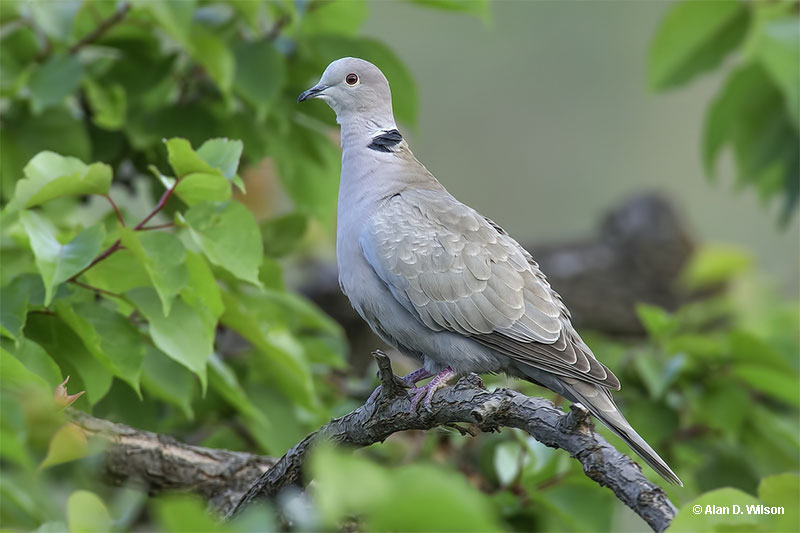
Scientific name: Streptopelia decaocto
Length: 13 inches
Weight: 7 ounces
Wingspan: 22 inches
Song: “hoo hoo hoowuh hoo WUH hoowuh hoo WUH!”
The Eurasian Collared-Dove is a medium to large, pale tan and gray dove with a black mark on its nape. Males and females look similar, have a slender black beak, and narrow gray eyering.
Eurasian Collared-Doves have black primaries and white in their tail feathers. These field marks are especially visible in flight.
These doves feed on grain and seeds picked from the ground and they can also visit feeders. In some places, Eurasian Collared-Doves occur in large flocks, especially around farms and grain silos.
The Eurasian Collared-Dove makes messy stick nests in trees and on structures near people. This species is highly adapted to living with and near people and prefers to feed in farm fields, gardens, towns, and other places where they can find grain and seeds.
This Eurasian species was accidentally introduced to North America in the 1970s and 1980s. It now occurs in parts of Alaska and much of Canada and the USA, including Wyoming.
Key Identifications:
- Fairly large, pale tan and gray dove with black primaries and white in its longish tail.
- Forages for grain and seeds on the ground.
- Makes messy stick nests in gardens, parks, and on farms.
- This dove species often calls and makes a typical dove-like sound, “hoo hoo hoowuh hoo WUH hoowuh hoo WUH!”.
European Starling
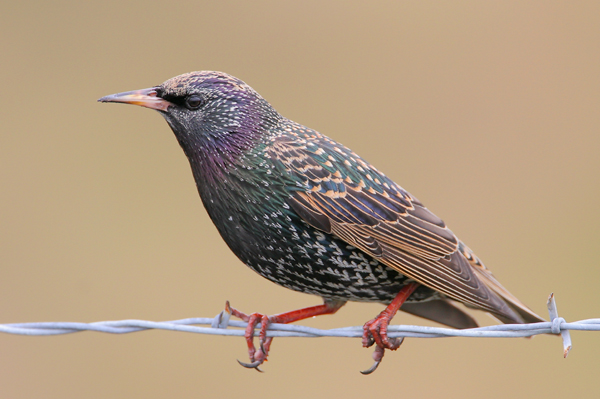
Photograph © Greg Lavaty.
Scientific name: Sturnus vulgaris
Length: 8.5 inches
Weight: 2.9 ounces
Wingspan: 16 inches
Song: “tiktiktitZHREEree..tiktiktik..ZHREE”
European Starlings are plump, short-tailed birds with long sharp beaks and longish pointed wings. In summer, they have yellow beaks, glossy black plumage with purple and green highlights, and some small white spots.
Males and females are similar, but males have less spotting and glossier plumage. In winter, they have black beaks, white spots, and more reddish colors in their wings.
Young starlings are shaped like adults but are grayish birds with a dark beak and a pale throat.
This species feeds on a variety of insects, fruit, and seeds. They can dominate bird feeders and are common species in urban areas, parks, farmlands, and other open habitats.
This European Starling builds a soft cup nest in a tree cavity, nest box, or suitable cavity in other structures.
European Starlings flock with each other and blackbird species, especially during the winter. They live across a large part of Canada and the USA.
Key Identifications:
- Rotund, short-tailed bird with a long, sharp beak, and pointed wings. Glossy black with some spotting in the summer and blackish with heavy white spotting and streaking in the winter.
- Feeds on seeds, fruit, and insects. Visits feeders and forages on the ground in flocks.
- Builds a soft cup nest in nest boxes and other cavities.
- The European Starling makes a wide variety of mechanical and whistled sounds. They also mimic other birds and sounds in their environment. They sing long, jumbled mechanical-sounding songs, “tiktiktitZHREEree..tiktiktik..ZHREE”.
Dark-eyed Junco
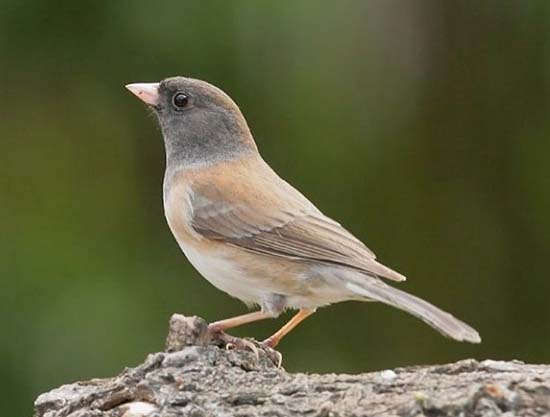
Scientific name: Junco hyemalis
Length: 6.25 inches
Weight: .67 ounces
Wingspan: 9.25 inches
Song: “sipsipsipsipsipsipsip”
Dark-eyed Juncos are sparrow-like birds with pale conical bills and dark eyes. This small bird has variable plumage with most being slate gray or gray and brown with white on their bellies, and white under their tails.
Other plumages include birds with dark masks and faint white wing bars, juncos with pale gray hoods and pinkish sides, and birds with blackish hoods and chestnut sides.
In flight, all Dark-eyed Juncos show extensive white in their longish tails.
This species feeds on seeds, insects, and some fruit and grain. Juncos forage on the ground in wooded areas, parks, and other habitats. They also feed on fallen seed beneath feeders.
They build cup nests on the ground under fallen logs, in roots, and other hidden spots. After breeding, juncos form flocks that forage together in similar wooded and semi-open habitats.
Dark-eyed Juncos are common birds in Canada, the USA, and parts of Mexico.
Key Identifications:
- Sparrow-like gray and brown bird with dark eyes, a pale beak, and white in the tail.
- Forages for seeds and insects on the ground, can feed on seeds at and beneath feeders.
- Builds a cup-shaped nest on the ground in tree roots, under logs, and other hidden places.
- This species often makes a sharp, high-pitched chip note, “pik!”. On breeding grounds, males sing a short, plain trill, “sipsipsipsipsipsipsip”.
Northern Flicker
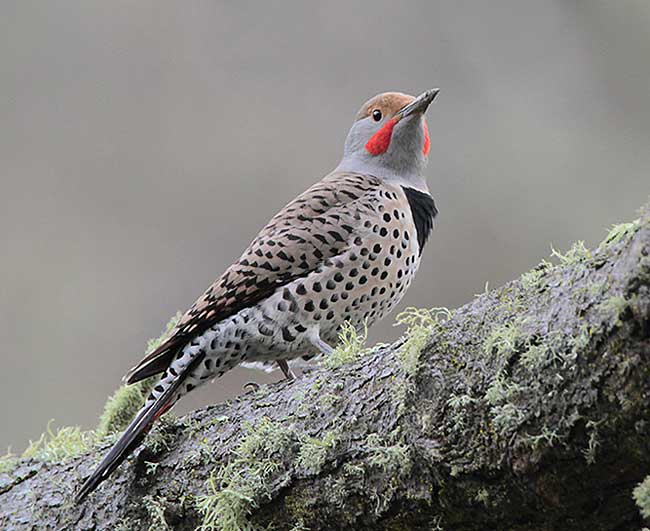
Scientific name: Colaptes auratus
Length: 12.5 inches
Weight: 4.6 ounces
Wingspan: 20 inches
Song: “kick,kick,kik,kik,kik.kik.kik.kik.kik.kik.kik.kik!”
Northern Flickers are fairly large, tan woodpeckers with barring on their backs. They have a black mark on their breast, black spotting below, and a dark, stout beak.
Males in the east have a tawny throat and face with a black mustache and small red spot on the back of their heads. Males in the west mostly have gray heads with red mustaches. Female Northern Flickers look like males but lack the mustache mark.
In bounding flight, they have white rumps and flash color on their underwings. This is bright yellow in eastern birds and reddish in flickers west of the Rocky Mountains.
This woodpecker eats many ants and other insects that it catches on the ground. It forages by flying to the ground, locating anthills, and lapping them up with its long tongue.
Northern Flickers nest in tree cavities and live in wooded and open habitats in Canada, the USA, and Mexico.
Key Identifications:
- Tan and gray woodpecker with black barring above, black marks below, and a bright, white rump.
- Forages for ants and other insects on the ground.
- Nests in tree cavities.
- A vocal woodpecker, the Northern Flicker often gives loud, “flicka,flicka,flicka” calls, and another loud, single note that sounds like, “Keer!” They also have a long, laughing vocalization of repeated notes, “kick,kick,kik,kik,kik.kik.kik.kik.kik.kik.kik.kik!”.
American Crow

Scientific name: Corvus brachyrhynchos
Length: 17.5 inches
Weight: 1 pound
Wingspan: 39 inches
Song: “Caw! Caw!”
The American Crow is a big, all-black bird with a strong, stout bill. In certain lighting, it can have metallic purple and blue iridescence.
Both sexes look the same and have some feathering on their beaks, long, broad wings, and a broad tail.
American Crows have a direct flight with strong, steady wing beats. Crows are very social and intelligent birds that are usually seen in flocks. They forage together on the ground or in trees and eat just about anything they can find.
Some of their more regular foods include carrion, fruit, nuts, seeds, insects, and small animals. Like most jays and crow species, they also eat the eggs and nestlings of other bird species.
This species builds bulky stick nests high in trees and lives in most habitats except for high mountains and arid zones.
The American Crow occurs in southern Alaska and much of Canada and the USA.
Key Identifications:
- Big, all black bird with long, broad wing and a broad tail.
- Forages for carrion, fruit, seeds, insects, and small animals.
- Builds a bulky stick nest high in a tree.
- American Crows are very vocal birds. They can make several calls but their most common one is, “Caw! Caw! Caw!”.
Black-capped Chickadee
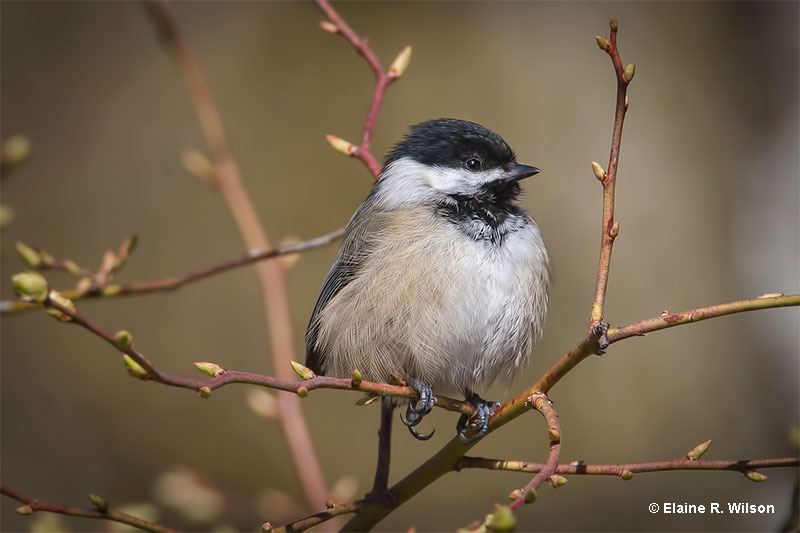
Scientific name: Poecile atricapilla
Length: 5.25 inches
Weight: .39 ounces
Wingspan: 8 inches
Song: “see bee, see bee”
Black-capped Chickadees are small grayish birds with a black cap, black throat, and a stubby black beak. Both sexes look alike and have a white face, white edging to the feathers in their wings, and some buff on their underparts.
These cute little birds feed on caterpillars, insects, spiders, seeds, and fruit. They are regular visitors to feeders but also forage on bark, twigs, and in foliage. When foraging, they hang upside down from twigs and usually occur in small flocks.
This species makes a small, soft nest out of moss and deer hair. It builds its nest in tree cavities and can also use nest boxes.
Black-capped Chickadees live in a variety of wooded habitats and can also occur in gardens. They are year-round residents in parts of Alaska, Canada, and the northern USA south to Oregon, northern New Mexico, northern Ohio, and the Appalachian Mountains to North Carolina.
Key Identifications:
- Small, cute, grayish birds with a black cap, white face, and a black throat.
- Forages for insects, spiders, seeds, and fruit in wooded habitats. Also visits feeders.
- Nests in tree cavities and nest boxes.
- This little bird is quite vocal and often says its name, “chick-a-deedeedeedeedee”. They also make other chattering calls and sing a whistled song, “see bee, see bee”.
Red-winged Blackbird
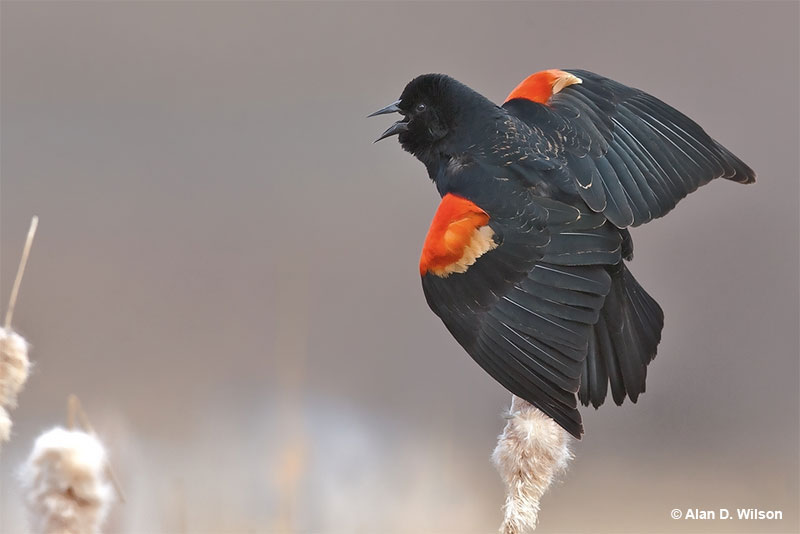
Scientific name: Agelaius phoeniceus
Length: 8.75 inches
Weight: 1.8 ounces
Wingspan: 13 inches
Song: “kan-keree!”
The Red-winged Blackbird is a medium-sized blackbird species with a sharp, black bill. Males also have a scarlet patch with a pale yellow border on the shoulder of each wing.
Female Red-winged Blackbirds are dark, heavily streaked, brownish-gray birds with an orange-buff eyebrow and throat. She can also have a little bit of dingy red on her shoulder.
Red-winged Blackbirds often flock together and form large groups in the winter. They feed on seeds, grain, and insects found on lawns, in marshes, farm fields, and other open habitats.
This species builds a cup nest of leaves and dead stems in a bush or other low vegetation in a marsh, park, or brushy field.
Red-winged Blackbirds are very common birds that live in all sorts of open habitats. We see them in parks, farming areas, and marshes in much of Canada, the USA, Mexico, and parts of the Central America.
Key Identifications:
- Males are medium-sized blackbirds with bright red patches on their wings. Females are heavily streaked, have a sharp black beak, and buff on the head.
- Feeds on seeds, grain, and insects on the ground in many open habitats.
- Builds a cup nest in a bush or other low vegetation.
- Red-winged Blackbirds often call. Males sing a loud, “kan-keree!” and both sexes also make “check!” calls and a high-pitched whistle-like sound.
Mountain Chickadee
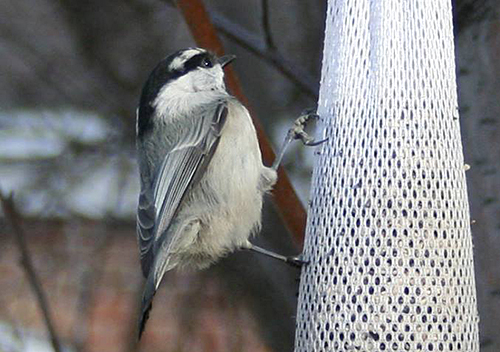
Scientific name: Poecile gambeli
Length: 5.25 inches
Weight: .39 ounces
Wingspan: 8.5 inches
Song: “pifeeee bee bee!”
The Mountain Chickadee is a small, pale, frosty gray bird with a black cap, white eyebrows, and black throat. Both sexes look alike and have small, stout black beaks.
This species mostly feeds on beetles, caterpillars, aphids, other insects, and spiders. It finds food by picking these food items from coniferous twigs and branches. The Mountain Chickadee usually forages in flocks with other chickadees and warblers.
Mountain Chickadees also visit bird feeders at any time of the year and forage for seeds of pinyons and other conifers in the winter.
This small cute bird makes a soft, cup nest of moss, lichen, and animal fur. It builds its nest in a tree cavity, nest box, or in tree roots.
Mountain Chickadees are year-round residents of coniferous forests in western Canada and the western USA. As long as conifers are present, they can also occur riparian zones.
Key Identifications:
- Small frosty gray bird with a black cap, black throat, and white eyebrows.
- Picks insects and spiders from coniferous vegetation, also eats conifer seeds in winter, and at feeders.
- Makes a soft cup nest of moss, lichen, and fur in tree cavities or nest boxes.
- Often calls and makes a “chick a dee dee dee” vocalization and a whistled, pifeeee bee bee”.
American Goldfinch
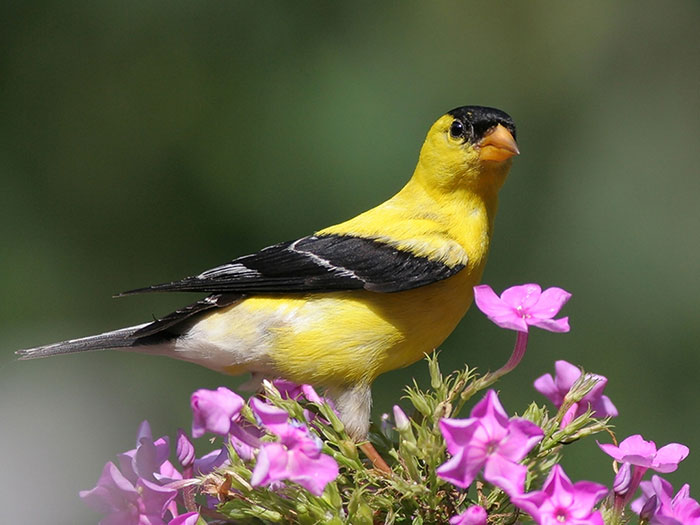
Scientific name: Carduelis tristis
Length: 5 inches
Weight: .46 ounces
Wingspan: 9 inches
Song: “swit sweet, sipsipsipchichisweetsweet”
The American Goldfinch is a small, sparrow-sized finch with a black and white, slightly forked tail, pale rump, and white undertail. In summer, males are bright lemon yellow with a small black cap, pale beak, and white markings on long black wings.
Females and wintering birds have two pale wing bars and have plain gray, buff, and yellowish plumage. This species often occurs in small flocks and has bounding flight.
American Goldfinches feed on seeds. They forage by picking them from grass, thistle, other low plants, Alders, and other trees. Goldfinches are also frequent visitors to bird feeders.
The American Goldfinch uses plant matter and other soft materials to build a small, tightly woven cup nest high in a shrub or a low tree.
American Goldfinches are summer residents in southern Canada, California, and the northern half of the USA, and winter in most of the USA and parts of Mexico.
Key Identifications:
- Small, bright yellow finch with a black cap, wings and tail (summer male), female and winter males are plain brown, buff, and yellowish birds with two pale wing bars.
- Feeds on seeds in low plants, trees, and at feeders.
- Makes a tightly woven cup nest high in a shrub or low tree.
- Often gives a “per chickory” call in flight and sings a short, trilled song, “swit sweet, sipsipsipchichisweetsweet”.
Red-breasted Nuthatch

© Elaine R. Wilson
Scientific name: Sitta canadensis
Length: 4.5 inches
Weight: .35 ounces
Wingspan: 8.5 inches
Song: “yeank, yeank, yeank”
The Red-breasted Nuthatch is a small, warbler-sized bird with a dark gray, straight or slightly upturned beak, gray upperparts, and reddish-orange underparts. It also has a black cap, a white face with a narrow black mask, and black and white in its short tail.
Males and females are similar, except that females are paler and have a gray cap.
Red-breasted Nuthatches eat insects during the summer and conifer seeds in the winter. These small, animated birds forage by creeping down coniferous tree trunks and on branches. They use their bills to probe bark and pick out insects and seeds.
This species excavates a tree cavity and makes an open nest of bark and other vegetation.
The Red-breasted Nuthatch lives in coniferous and mixed forests in southern Alaska, Canada, and the western and northern USA. They also breed in the Appalachians and can be seen in most of the USA in winter.
Key Identifications:
- Small, short-tailed bird with a narrow white eyebrow, black mask, gray upperparts, and reddish-orange underparts.
- Creeps along tree trunks and branches to forage for insects and conifer seeds.
- Nests in tree cavities.
- The distinctive nasal call of the Red-breasted Nuthatch, “yeank, yeank, yeank”, is a good way to find this bird.
Yellow-rumped Warbler
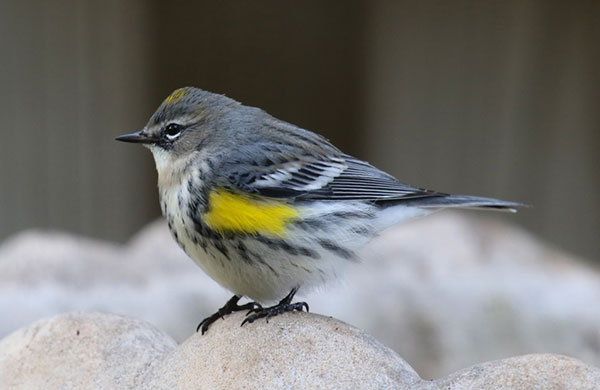
Scientific name: Setophaga coronata
Length: 5.5 inches
Weight: .42 ounces
Wingspan: 9.25 inches
Song: “si,sit,sit,sit,sit,sue,sue,sue”
The Yellow-rumped Warbler is a small, blue-gray songbird with a yellow rump, crown, and yellow patches on each side of its breast. It also has two white wing bars, dark marks on the back, and white underparts with blackish markings on its breast and sides.
This species has a blackish face and white markings above and below the eyes in summer. Females are like males but duller. In winter, both sexes of Yellow-rumped Warblers are duller and have more brownish plumage.
The western subspecies has a yellow throat and more white in the wings.
This species feeds on insects and small berries. It picks food from vegetation and briefly flies into the air to catch bugs in flight.
Yellow-rumped Warblers build small cup nests in conifers in Canada and the northeastern and western USA. They spend the winter in semi-open habitats from the southern USA to Central America.
Key Identifications:
- Small songbird with two pale wing bars and yellow patches on the rump, each side of its breast, and crown.
- Feeds on insects and small berries.
- Builds cup nests in conifers in northern and montane forests.
- The Yellow-rumped Warbler makes a sharp call note, “chup!”, and sings a brief and easy-going warbling song, “si,sit,sit,sit,sit,sue,sue,sue”.
Red-tailed Hawk
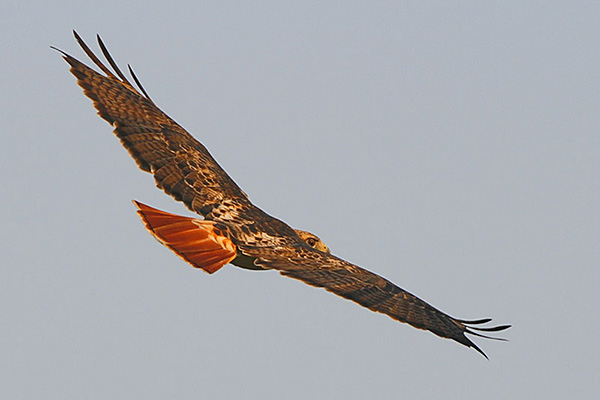
Scientific name: Buteo jamaicensis
Length: 19 inches
Weight: 2.4 pounds
Wingspan: 49 inches
Song: “Kreeeyahh!”
The Red-tailed Hawk is a large and chunky raptor with a broad, orange or reddish tail. Males and females look alike, but it’s important to remember that females are larger.
These raptors are dark brown above and are pale below, with dark markings on their belly. Young birds are more streaked on their underparts and have brown tails with dark barring.
Red-tailed Hawks often soar and have long, broad wings that can show pale square patches on the bases of their primaries. While soaring, they watch for squirrels and other small animals that they feed on.
When they spot prey, these big birds drop down to catch it with their talons. This hawk also hunts by watching for prey from a perch.
The Red-tailed Hawk builds a large, bulky stick nest high in trees. They thrive in a wide variety of habitats, but especially in woodlands near fields and other open habitats.
This raptor lives from Alaska and Canada south to Central America.
Key Identifications:
- Large, bulky hawk with a broad, reddish tail.
- Catches squirrels, rats, pigeons, and many other small animals on the ground.
- Nests in large, bulky nests made of sticks.
- A vocal raptor, Red-tailed Hawks often call in flight. They usually give a “classic” but quiet sounding raptor scream, “Kreeeyahh!”.
Bald Eagle
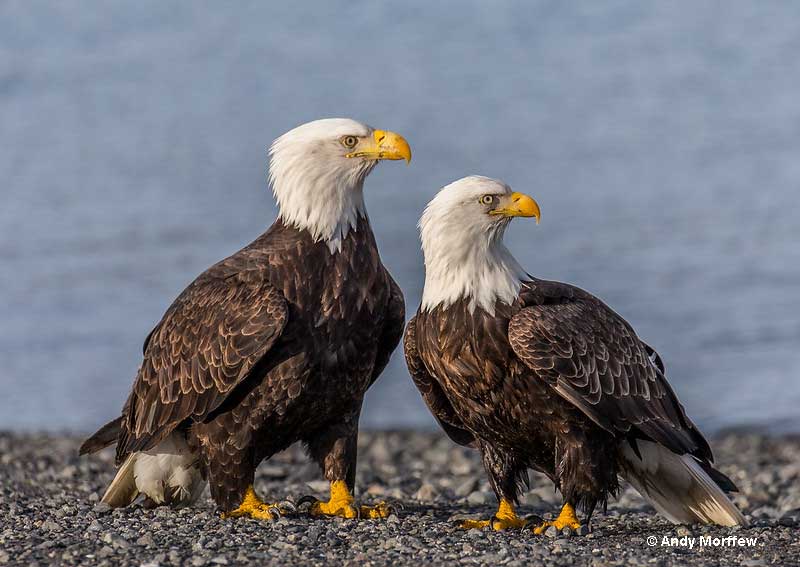
Judging by the size, female is on the left and male is on the right. Photograph © Andy Morffew
Scientific name: Haliaeetus leucocephalus
Length: 31 inches
Weight: 9.5 pounds
Wingspan: 80 inches
Song: “pip pipipipip!”
The Bald Eagle is a huge, dark brown raptor with a white head, white tail, and a big yellow beak. Males and females look the same, except that females are bigger.
Young birds are dark brown with mottled white and have a mostly dark beak.
In flight, Bald Eagles soar on broad, long wings held flat like a board. They also have deep and slow wing beats.
The Bald Eagle snatches fish from the surface of lakes, rivers, and other shallow wetlands. It also feeds on carrion and occasionally catches small mammals and birds as big as a Canada Goose.
This big raptor builds a big, bulky stick nest high in a tree in or near wetlands. They often use the same nest year after year.
Bald Eagles occur in a variety of wetland habitats in Alaska, Canada, most of the USA (including Wyoming), and in some parts of northern Mexico.
Key Identifications:
- Although adult Bald Eagles are unmistakable, young birds can be confused with the Golden Eagle. They are best recognized by their mottled plumage, huge beak, and flat, soaring wings.
- Preys on fish, small mammals, ducks and geese, and also eats carrion.
- Builds a big, bulky nest out of sticks in wetland habitats.
- Bald Eagles make brief, whistled piping calls, “pip pipipipip!”.
Western Meadowlark
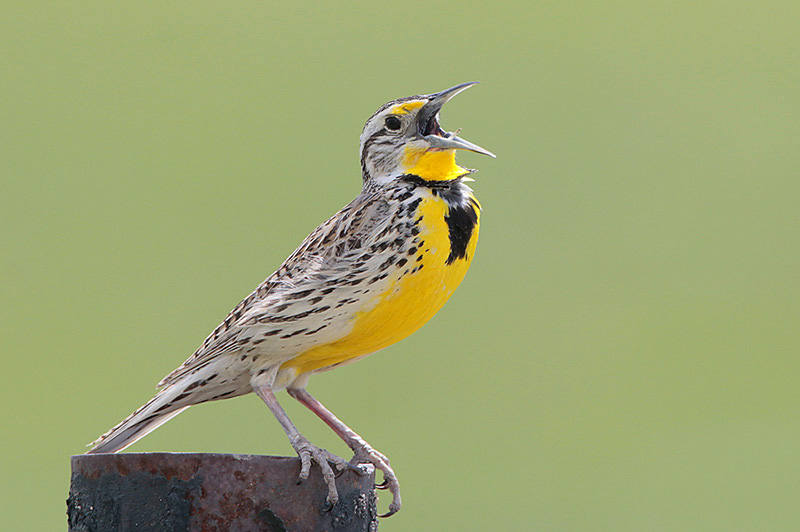
Scientific name: Sturnella neglecta
Length: 9.5 inches
Weight: 3.4 ounces
Wingspan: 14.5 inches
Song: “trip tree tur ripuhdip”
The Western Meadowlark is a chunky, pale brown and yellow bird with a long, straight beak. Males and females look alike and have a large black “V”-shaped mark on their bright yellow breast. The rest of their underparts are white, with some dark marks on their flanks.
They also have a narrow white stripe down the middle of their dark crown, a long yellow and white eyebrow, and a pale face with a dark line going back from their eyes.
This bird shows white in the tail, especially in flight, and has a little yellow on the lower part of the face.
Western Meadowlarks forage on the ground in open habitats for insects and seeds.
This species uses grass and other bits of vegetation to make a hidden nest on the ground.
The Western Meadowlark lives in a variety of open habitats in parts of Canada, the central and western USA, and Mexico. They happen to carry the title of being the state birds of Wyoming.
Key Identifications:
- Robin-sized, pale brown and yellow rotund bird with a black “V” mark on its breast.
- Forages for insects and seeds on the ground in open habitats.
- Makes a hidden, dome-like nest out of grass and soft vegetation on the ground.
- This birds has a rattle call, often in flight, and sings a pleasant, melodious whistled song, “trip tree tur ripuhdip”.
Mourning Dove
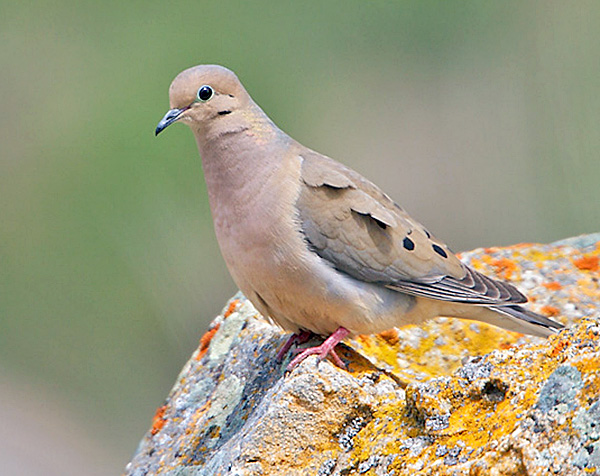
Photograph © Greg Lavaty.
Scientific name: Zenaida macroura
Length: 12 inches
Weight: 4.2 ounces
Wingspan: 18 inches
Song: “hooOOA, hoo, hoo, hoo”
Mourning Doves are medium-sized, grayish-brown doves with long tails. They have small black spots on their wings and a small head with a slender, dark beak.
Males and females also have narrow gray eyerings, a black mark on the face, and pale iridescent gold on the sides of their necks. Females look similar to males except for males having more gray on the head and neck, and more iridescence.
This dove has fairly long wings and swift, direct flight. When flying, it shows black and white on its tail.
The Mourning Dove occurs in woodlands, gardens, on farms, and in urban areas. This common feeder visitor eats seeds and grains. It also forages in open situations, picking food from the ground.
This pleasant dove species can visit a feeder on its own or forage in small flocks. It builds an unkempt stick nest in bushes and trees and is very common throughout the USA, southern Canada, and Mexico.
Key Identifications:
- Plain brown and gray dove with a long, pointed tail.
- Feeds on seeds at feeders and on the ground in open areas.
- Makes a small, messy nest of sticks in trees.
- Sings a sad and owl-like “hooOOA, hoo, hoo, hoo”.
Pine Siskin
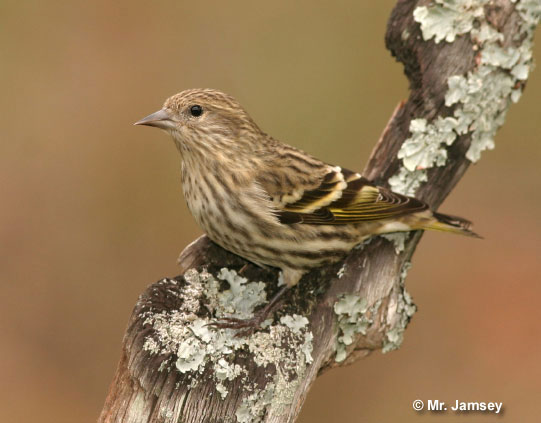
Scientific name: Carduelis pinus
Length: 5 inches
Weight: .53 ounces
Wingspan: 9 inches
Song: “chupchup chititititi zhreeee chittitititchititichichup”
The Pine Siskin is a small, grayish-brown finch with a sharp, thin, conical beak. Males and females have brown streaking above and much streaking on their underparts.
They both have a white belly, long wings, and a rather short, slightly forked tail.
However, females have two white wing bars while males have one or two yellow wing bars. Males can also have more yellow in their plumage, including in their tail.
Pine Siskins eat a wide variety of seeds. They forage for grass seeds, and seeds of coniferous and deciduous trees like Alder and Birch. This species is also regular at seed feeders.
This finch species makes a small cup nest out of moss, lichens, grass, and other bits of vegetation.
The Pine Siskin breeds in boreal forests in Canada and parts of the northern USA, and in coniferous forests in the western USA. It winters in many parts of the USA, Canada, and parts of Mexico, making them one of the most popular birds of Wyoming.
Key Identifications:
- Small, grayish-brown, streaked finch with wing bars and a thin conical beak.
- Forages in trees, bushes, and at feeders for seeds.
- Makes a small cup nest of moss and other bits of vegetation, high in a tree.
- Has a long, complex, hurried songs of chittering and harsh notes, “chupchup chititititi zhreeee chittitititchititichichup”. Also makes some brief call notes and a rising call, “zhreeee”.
Song Sparrow
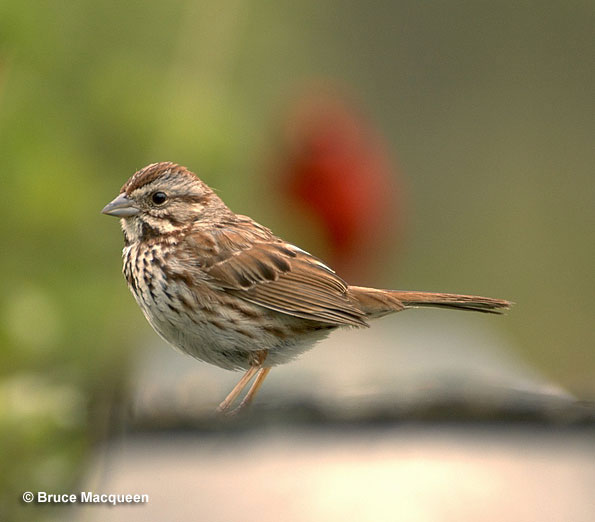
Scientific name: Melospiza melodia
Length: 6.25 inches
Weight: .7 ounces
Wingspan: 8.25 inches
Song: “seet serate sitsziziziziziziziz seet”
The Song Sparrow is a small gray and brown songbird with a thick dark mark on each side of its white throat. Males and females look the same and have white underparts with a dark brown mark on their breast, and dark brown streaks on their breast and sides.
Most Song Sparrows also have two narrow wing bars and show a rounded tail when fluttering between bushes.
This species feeds on insects, seeds, and small fruits. Pairs forage by picking up food items on and near the ground. They are also frequent visitors to bird feeders.
Song Sparrows use grass, stems, hair, and other materials to make a cup nest placed on or near the ground. They nest in dense vegetation, shrubbery, or low trees, often near water.
This species uses a wide variety of brushy habitats in open and wooded situations in southern Alaska, most of Canada, and all of the USA.
Key Identifications:
- Small brown, streaked sparrow with a dark mark on its breast.
- Forages on and near the ground for seeds and insects in brushy habitats.
- Builds a cup nest on or near the ground in a shrub or low tree.
- Makes high-pitched “tink”, chirping calls, and has a cheerful song with a trill, “seet serate sitsziziziziziziziz seet”.
White-crowned Sparrow
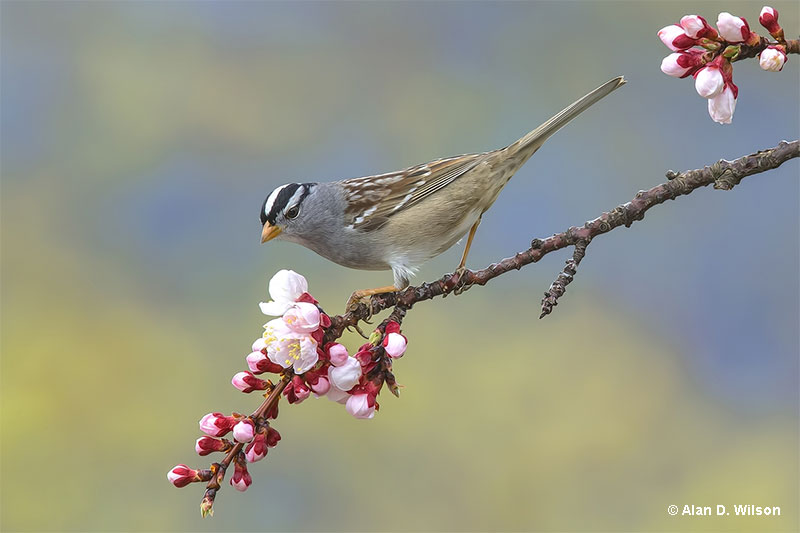
© Alan D. Wilson
Scientific name: Zonotrichia leucophrys
Length: 7 inches
Weight: 1 ounce
Wingspan: 9.5 inches
Song: “tuuur teeteetee zhree zhree zeh”
The White-crowned Sparrow is a thrush-sized sparrow with black and white stripes on its head, and a small, finch-like orange or pinkish beak.
Both sexes look alike and have a gray face, gray underparts with pale brown flanks, streaked brown back, and gray-brown rump. Their rounded wings are mottled brown with two pale wing bars.
In winter, young birds have brown and tan stripes on their head.
The White-crowned Sparrow feeds on insects, seeds, grass, buds, and fruit. It forages by picking food items from the ground and in low vegetation. In winter, this species moves around forest and park-like habitats in flocks.
This sparrow makes a cup nest out of grass, bark strips, and other plant matter and builds it on the ground or in a low bush.
White-crowned Sparrows live in shrubby habitats in Alaska, Canada, the Rocky Mountains, along the Pacific Coast, and winter in much of the western, central, and eastern USA.
Key Identifications:
- Thrush-sized sparrow with a black and white striped head, gray underparts, orange or pinkish finch-like beak, and two wing bars.
- Eats insects, seeds, and fruit on and near the ground, often in flocks.
- Makes a cup nest on or near the ground.
- Makes a sharp call, “Pick!” and sings a pleasant song, “tuuur teeteetee zhree zhree zeh”.
Yellow Warbler
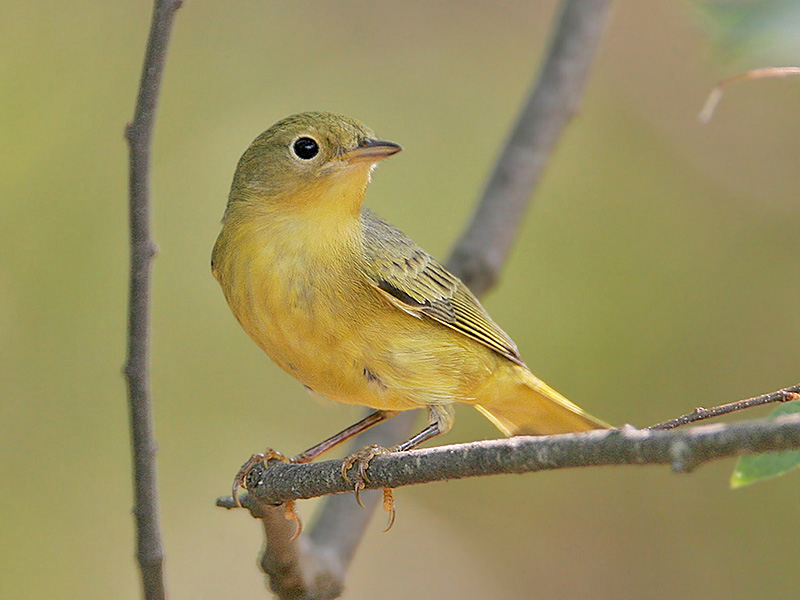
Scientific name: Setophaga petechia
Length: 5 inches
Weight: .33 ounces
Wingspan: 8 inches
Song: “sweet sweet sweet swisisi sweet”
The Yellow Warbler is a small yellow bird with a sharp beak. Both sexes are yellow birds with olive-yellow upperparts, and have long wings with a hint of two yellow wing bars.
Males in breeding plumage are brighter yellow and have chestnut streaks below. Females and juveniles lack streaks and are duller. All Yellow Warblers have yellow spots in their tails.
Yellow Warblers feed on various insects and arthropods. They forage by quickly moving through vegetation and picking food from the foliage. They can also sally to catch insects in flight.
This species uses grass, bark strips, plant fiber, and other materials to make a deep cup nest. They build their nests in a bush or small tree.
The Yellow Warbler breeds in a variety of second-growth habitats in Alaska, Canada, much of the western USA, and in the eastern USA, south to northern Georgia. It winters in edge habitats from Mexico to northern South America.
Key Identifications:
- Small yellow bird with a sharp beak. Males have chestnut streaks below.
- Forages for insects in bushes and trees, usually in edge habitats.
- Makes a deep cup nest of bark strips and plant fibers in a bush or low tree.
- Has a sweet-sounding sound of ringing notes, “sweet sweet sweet swisisi sweet”. It also makes sharp chip calls.
Common Merganser
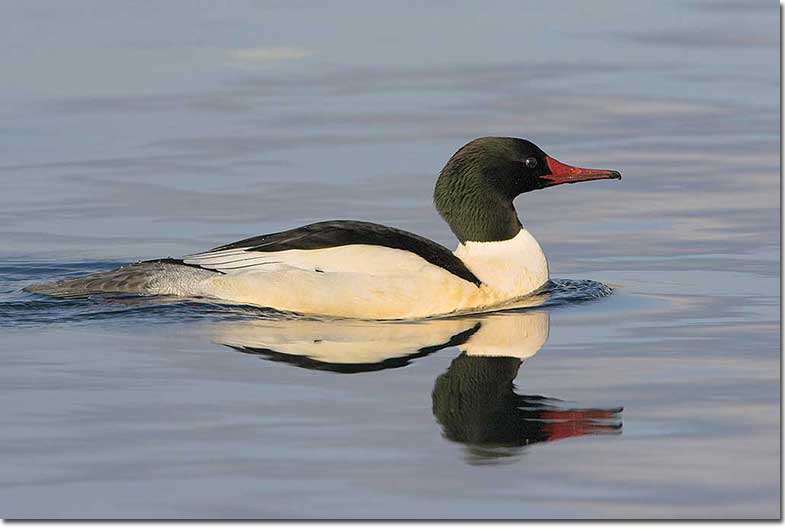
Scientific name: Mergus merganser
Length: 25 inches
Weight: 3.4 pounds
Wingspan: 34 inches
Song: “kook kuh ruh rah ruh rah”
The Common Merganser is a big diving duck with a pointed red-orange beak, and a large white patch in each wing.
Breeding males are ivory white with a glossy black-green head. They also have a black and white back and wings, and a wedge-shaped gray tail.
Females, juveniles, and non-breeding males are gray, have a white belly, brown head, and white throat.
Common Mergansers eat small fish, and also catch insects, crustaceans and other small animals. They forage by diving below the surface and snatching prey with their long, hooked beak.
This species nests in tree cavities and other holes and crevices. They line the bottom of the nest hole with wood chips and down feathers.
The Common Merganser breeds in forested lakes and rivers in Alaska, Canada, and the northern and western USA. They also live in Iceland and Eurasia. This species winters on lakes, reservoirs, and coastal waters in Canada and the northern and western USA.
Key Identifications:
- Large black and white or gray and white duck with a dark head and a pointed red-orange beak.
- Dives underwater to catch small fish and other small animals.
- Nests in a woodpecker hole or other cavities in forested areas near lakes and rivers.
- Occasionally makes croaking sounds, ““kook kuh ruh rah ruh rah””.
Gadwall
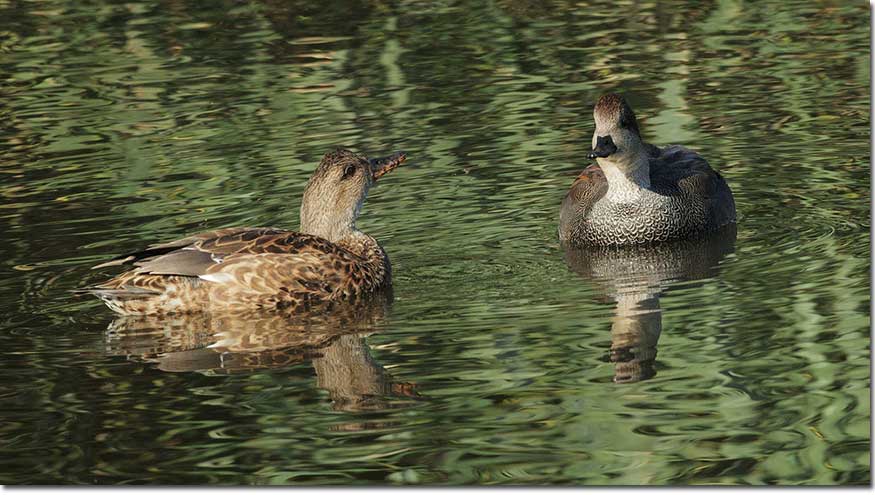
Scientific name: Mareca strepera
Length: 20 inches
Weight: 2 pounds
Wingspan: 33 inches
Song: “reh reh reh reh reh”
The Gadwall is an average-sized duck with a white belly and a small white patch in each wing. The male is gray with some tan on its wings, and has a pale, gray-brown head and black beak.
The male Gadwall also has a black rump and undertail. The female Gadwall is mottled gray-brown and buff with a plain grayish head and has a gray and orange beak.
Gadwalls forage for seeds and aquatic plants by dipping below the surface and using their beaks to pick up food items. They often occur in flocks of a hundred or so birds.
This duck species nests on the ground in meadows and other areas with tall grass. It makes a shallow scrape hidden in dense vegetation.
The Gadwall breeds in wetlands in southern Alaska, and in western, central, and southern Canada. It also breeds in the western, central, and eastern USA, and winters in wetlands in the western, central, and southern USA.
Key Identifications:
- Gray duck with a black beak, black rump and undertail (the male), or buff and gray-brown with an orange and gray beak. Both sexes have a white belly and small white wing patch.
- Dabbles for aquatic plants and seeds in wetlands.
- Makes a shallow scrape on the ground in meadows and other spots with dense grassy vegetation.
- Makes nasal, rasping quacking calls, “reh reh reh reh reh”.
Killdeer
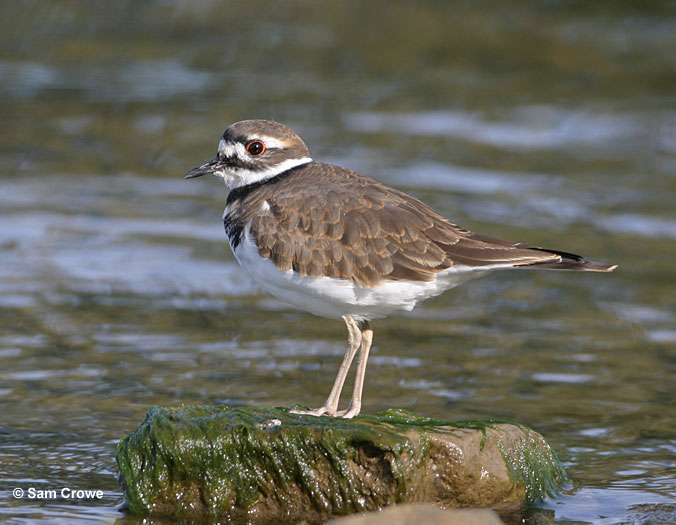
Scientific name: Charadrius vociferus
Length: 10.5 inches
Weight: 3.3 ounces
Wingspan: 24 inches
Song: “tideer, tideer, tideer, tideer”
The Killdeer is a fair-sized, slender plover that is dark brown above and white below. They have two black bands on their breast, a patterned, black, white, and dark brown face, and a longish, orange tail.
Both sexes look alike and also have a slender, black bill, narrow, red-orange eyerings, and long, pale legs. In flight, we can see a white stripe in each of their long, dark wings and a black tip on their long, wedge-shaped, orange tail.
Killdeers often fly high overhead in fast, direct flight, but we usually see them foraging on the ground. They pick insects, other small creatures, and seeds from the edges of wetlands and other, open grassy areas.
This species lays its camouflaged eggs on the ground, in gravel and open fields. When people and pets approach too close, they give loud calls and pretend to have a broken wing.
The Killdeer lives in large parts of Canada, the USA, Mexico and also Wyoming.
Key Identifications:
- Fair-sized plover with two black breast bands and a wedge-shaped orange tail with a black tip.
- Picks seeds and small creatures from open ground.
- Lays camouflaged eggs on the ground, in gravel and open fields.
- Very vocal and sounds like it says its name, “tideer, tideer, tideer, tideer”.
Rock Pigeon
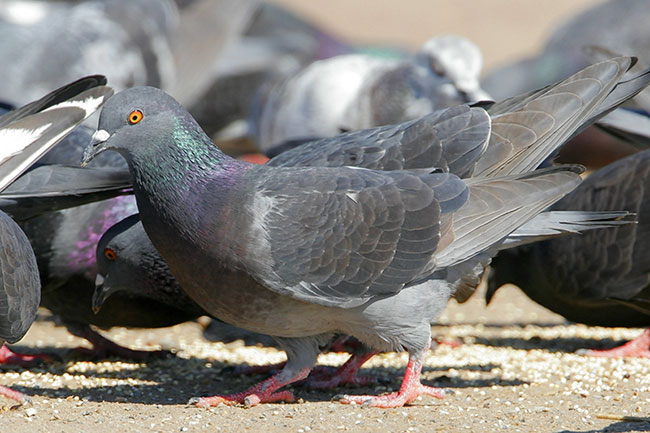
Scientific name: Columba livia
Length: 12.5 inches
Weight: 9 ounces
Wingspan: 28 inches
Song: “tititik grewh”
The Rock Pigeon is the familiar and common “pigeon” of cities, farms, and other urban situations. Although this pigeon can show a variety of plumages, the most frequent one is pale gray with dark gray on the head and neck and a dark gray tail with a dark tip.
It also has iridescent green on its neck and two black wing bars.
This species has a quick and direct flight with rapidly beating wings.
Rock Pigeons usually occur in flocks and large ones can form in farm fields and some urban areas. They pick seeds and grain from the ground, mostly in open areas like farm fields, parks, and city streets.
The Rock Pigeon uses sticks and other stick-like objects to make a shallow nest on covered ledges of buildings and other structures.
Rock Pigeons are completely adapted to living with people and occur in urban and farming areas in most parts of North America, including Wyoming.
Key Identifications:
- Familiar gray pigeon with dark tip at the end of its tail and two black wing bars.
- Picks seeds and grain from the ground of streets, fields, and other open habitats.
- Makes messy stick nests on ledges with overhanging structures.
- Makes a gruffy vocalization, “tititik grewh”.
Birds of Wyoming – Frequently Asked Questions
How many bird species are native to Wyoming?
In total, 452 bird species are native to Wyoming. This is the number of birds that have been identified in the state of Wyoming.
What is the most common bird in Wyoming?
The most common bird in Wyoming is the American Robin. According to sightings on the eBird platform and breeding bird surveys, this species is seen more than any other bird in the state.
What is the largest bird in Wyoming?
The largest bird in Wyoming is the American White Pelican. This massive bird is 62 inches long, has a 9 foot wingspan, and weighs 16.4 pounds! The heaviest bird in Wyoming is the 23 pound Trumpeter Swan.
What is the smallest bird in Wyoming?
The smallest bird in Wyoming is the Calliope Hummingbird. This species is also the smallest bird in the USA. It is 3.25 inches long and only weighs 0.1 ounces.
Does Wyoming have a state bird?
Wyoming has a state bird. The state bird of Wyoming is the Western Meadowlark.
Are there crows or ravens in Wyoming?
Wyoming has both crows and ravens.
Do Cardinals live in Wyoming?
No, cardinals do not live in Wyoming. They are a very rare visitor to the state.
Are Magpies in Wyoming?
Yes, Magpies are in Wyoming. The Black-billed Magpie is a common bird in Wyoming.

